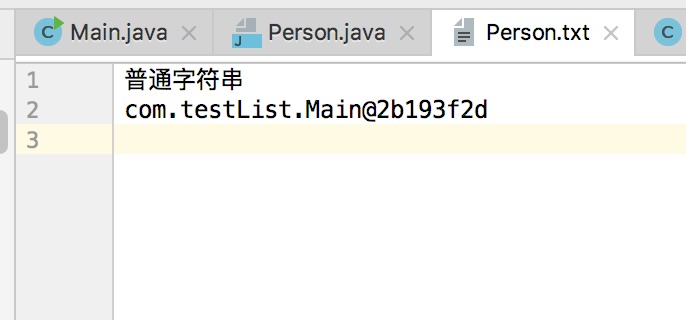廖雪峰Java6IO编程-2input和output-1inputStream
1.InputStream
1.1InputStream是所有输入流的超类:
- int read()
* 读取下一个字节,并返回字节(0-255)
* 如果已读到末尾,返回-1
* read()方法是阻塞(blocking)的,必须等待read()方法返回才能执行下一行代码 - int read(byte[]):读取若干字节并填充到byte[]数组,返回读取的字节数
- int read(byte[], int off, int len):指定byte[]数组的偏移量和最大填充术数。
- void close():关闭输入流
- 使用try(resource)可以保证InputStream正确关闭
代码一,使用close关闭文件:如果运行时发生IO错误,文件不能正确关闭,资源不能得到及时的释放
public class Main {
public static void main(String[] args) throws IOException {
InputStream input = new FileInputStream("./src/main/java/com/testList/Person.txt");
int n;
while((n=input.read())!= -1){
System.out.println(n);
}
input.close();
}
}
代码二:
public class Main {
public static void main(String[] args) throws IOException {
InputStream input = null;
try{
input= new FileInputStream("./src/main/java/com/testList/Person.txt");
int n;
while((n=input.read())!= -1){
System.out.println(n);
}
}finally {
if (input != null) {
input.close();
}
}
}
}
代码三,使用try(resource)保证InputStream正确关闭,推荐
public class Main {
public static void main(String[] args) throws IOException {
try(InputStream input = new FileInputStream("./src/main/java/com/testList/Person.txt")){
int n;
while((n=input.read())!= -1){
System.out.println(n);
}
}//自动关闭InputStream
}
}
代码四,利用缓冲区一次读取多个字节
public class Main {
public static void main(String[] args) throws IOException {
try(InputStream input = new FileInputStream("./src/main/java/com/testList/Person.txt")){
byte[] buffer = new byte[10];
int n;
while((n=input.read(buffer))!= -1){
System.out.println(Arrays.toString(buffer));
}
}
}
}
1.2常用InputStream
1.2.1 FileInputStream
FileInputStream是InputStream的实现类,可以从文件获取输入流。
try(InputStream input = new FileInputStream("./src/main/java/com/testList/Person.txt")){
byte[] buffer = new byte[10];
int n;
while((n=input.read(buffer))!= -1){
System.out.println(Arrays.toString(buffer));
}
1.2.2 ByteArrayInputStream
ByteArrayInputStream可以在内存中模拟一个InputStream。用的不多,可以测试的时候构造InputStream
public class Main {
public static void main(String[] args) throws IOException {
byte[] data = {-26, -103, -82, -23, -128, -102, -27, -83, -105, -25,-84, -90, -28, -72, -78, 10, 99, 111, 109, 46,116, 101, 115, 116, 76, 105, 115, 116, 46, 77,97, 105, 110, 64, 50, 98, 49, 57, 51, 102,50, 100, 10, 64, 50, 98, 49, 57, 51, 102};
try(InputStream input = new ByteArrayInputStream(data)){
byte[] buffer = new byte[10];
int n;
while((n=input.read(buffer))!= -1){
System.out.println(Arrays.toString(buffer));
}
}
}
}
1.3总结:
- InputStream定义了所有输入流的超类
- FileInputStream实现了文件输入
- ByteArrayInputStream在内存中模拟一个字节流输入
- 使用try(resource)保证InputStream正确关闭
2.OutputStream
2.1 java.io.OutPutStream是所有输出流的超类:
- abstract write(int b):写入一个字节
- void write(byte[] b):写入byte数组的所有字节
- void write(byte[] b, int off, int len):写入byte[]数组指定范围的字节
- write()方法是阻塞的,必须等待write方法执行完毕返回后才能执行下一行代码
- void close():关闭输出流
- 使用try(resource)可以保证OutputStream正确关闭
- void flush() :将缓冲区的内容输出
为什么需要flush呢?
因为像磁盘、网络写入数据的时候,出于效率的考虑,很多时候,并不是输出1个字节就立即写入。而是先把输出的字节放在内存缓冲区里,等到缓冲区满了之后,再一次性写入。对于很多设备来说,一次写入1个字节和写入1000个字节话费的时间是一样的。所以Output Stream有一个flush方法,能够强制把缓冲区的内容输出。通常情况下,我们不需要调用这个方法,因为缓冲区在满的时候,会自动调用flush。我们在调用close方法关闭OutputStream时,也会调用flush方法。
代码一:如果写入过程中发生IO错误,OutputStream不能正常关闭
public class Main {
public static void main(String[] args) throws IOException {
OutputStream output = new FileOutputStream("./src/main/java/com/testList/output.txt");
output.write(72);//1次写入1个字节
output.write(101);
output.write(108);
output.write(108);
output.write(111);
output.close();
}
}
代码二:通过try(resource)自动关闭文件
public class Main {
public static void main(String[] args) throws IOException {
try(OutputStream output = new FileOutputStream("./src/main/java/com/testList/output.txt")){
output.write(72);
output.write(101);
output.write(108);
output.write(108);
output.write(111);
}
}
}
代码三:一次传入多个字节
public class Main {
public static void main(String[] args) throws IOException {
try(OutputStream output = new FileOutputStream("./src/main/java/com/testList/output.txt")){
byte[] b = "hello,张三".getBytes("UTF-8");
output.write(b,3,9);
}
}
}
代码四:一次性写入
public class Main {
public static void main(String[] args) throws IOException {
try(OutputStream output = new FileOutputStream("./src/main/java/com/testList/output.txt")){
byte[] b = "hello,张三".getBytes("UTF-8");
output.write(b);
}
}
}
2.2 常用OutPutStream:
2.2.1 FileOutStream
FileOutStream可以输出到文件
2.2.2 ByteArrayOutPutStream
ByteArrayOutputStream可以在内存中模拟一个OutputStream
public class Main {
public static void main(String[] args) throws IOException {
try(ByteArrayOutputStream output = new ByteArrayOutputStream()){
output.write("Hello".getBytes("utf-8"));
output.write("world!".getBytes("utf-8"));
byte[] data = output.toByteArray();
System.out.println(Arrays.toString(data));
}
}
}
2.3 总结
- OutputStream定义了所有输出流的超类
- FileOutputStream实现了文件流输出
- ByteArrayOutputStream在内存中模拟一个字节流的输出
- 使用try(resource)保证OutputStream正确关闭
3.Input/OutPut练习
FileInputStream可以从文件读取数据,FileOutputStream可以把数据写入文件。
如果我们一边从一个文件读取数据,一边把数据写入到另一个文件,就完成了文件的拷贝。
请编写一个程序,接收两个命令行参数,分别表示源文件和目标文件,然后用InputSream/OutputStream把源文件复制到目标文件。
复制后,请检查源文件和目标文件是否相同(文件长度相同,内容相同),分别用文本文件、图片文件和zip文件测试。
使用FileInputStream读取文件
import java.io.File;
import java.io.FileInputStream;
import java.io.IOException;
public class Main {
public static void main(String[] args) throws IOException {
File f = new File("./src/main/java/com/testList/Person.java");
System.out.println(f.length());
//创建字节输入流
FileInputStream fis = new FileInputStream("./src/main/java/com/testList/Person.java");
//创建竹筒
byte[] bbuf = new byte[100];
//保存实际读取的字节数
int hasRead = 0;
//使用循环重复取水过程
while((hasRead = fis.read(bbuf))>0){
//取出竹筒中的水滴即字节,将字节数组转换成字符串输入
System.out.println(new String(bbuf,0,hasRead));
}
//关闭字节流
fis.close();
}
}
使用FileReader读取文件
import java.io.File;
import java.io.FileReader;
import java.io.IOException;
public class Main {
public static void main(String[] args) throws IOException {
File f = new File("./src/main/java/com/testList/Person.java");
System.out.println(f.length());
try(
//创建字符输入流
FileReader fr = new FileReader("./src/main/java/com/testList/Person.java")
){
//创建一个长度为100的竹筒
char[] cbuf = new char[100];
//hasRead用于保存实际读取的字符数
int hasRead = 0;
while((hasRead =fr.read(cbuf))>0){//使用循环重复取水过程
//取出竹筒中的水滴即字符,将字符数组转换为字符串输入
System.out.println(new String(cbuf,0,hasRead));
}
}catch (IOException ex){
ex.printStackTrace();
}
}
}
import java.io.*;
public class Main {
public static void main(String[] args) throws IOException {
try(
//创建字节输入流
FileInputStream fis = new FileInputStream("./src/main/java/com/testList/Person.java");
//创建字节输出流
FileOutputStream fos = new FileOutputStream("./src/main/java/com/testList/Person.txt")
){
byte[] bbuf = new byte[300];
int hasRead = 0;
//循环从输入流中取出数据
while ((hasRead = fis.read(bbuf))>0){
//取出1次,写入1次
fos.write(bbuf,0,hasRead);
}
}catch (IOException ex){
ex.printStackTrace();
}
}
}
import java.io.*;
public class Main {
public static void main(String[] args) throws IOException {
try(
//创建字节输出流
FileWriter fw = new FileWriter("./src/main/java/com/testList/Person.txt")
){
fw.write("于易水送人 - 骆宾王\r\n");
fw.write("此地别燕丹,壮士发冲冠。\r\n");
fw.write("昔时人已没,今日水犹寒。\r\n");
}catch (IOException ex){
ex.printStackTrace();
}
}
}
import java.io.*;
public class Main {
public static void main(String[] args) throws IOException {
try(
FileOutputStream fos = new FileOutputStream("./src/main/java/com/testList/Person.txt");
PrintStream ps = new PrintStream(fos)
){
ps.println("普通字符串");
ps.println(new Main());
}catch (IOException ex){
ex.printStackTrace();
}
}
}

廖雪峰Java6IO编程-2input和output-1inputStream的更多相关文章
- 廖雪峰Java6IO编程-1IO基础-1IO简介
1.IO简介 IO是指Input/Output,即输入和输出: Input指从外部读取数据到内存,例如从磁盘读取,从网络读取. * 为什么要把数据读到内存才能处理这些数据呢? * 因为代码是在内存中运 ...
- 廖雪峰Java15JDBC编程-3JDBC接口-5JDBC连接池
1. JDBC连接池 1.1 JDBC连接池简介 线程池可以复用一个线程,这样大量的小任务通过线程池的线程执行,就可以避免反复创建线程带来的开销. 同样JDBC可以复用一个JDBC连接 JDBC的连接 ...
- 廖雪峰Java15JDBC编程-3JDBC接口-4JDBC事务
1 数据库事务:Transaction 1.1 定义 若干SQL语句构成的一个操作序列 要么全部执行成功 要么全部执行不成功 1.2 数据库事务具有ACID特性: Atomicity:原子性 一个事务 ...
- 廖雪峰Java15JDBC编程-3JDBC接口-3JDBC更新
使用update语句的时候,需要通过JDBC实现update语句的执行,这个时候仍然通过PreparedStatement对象来使用,直接传入update语句,然后通过setObject传入占位符的值 ...
- 廖雪峰Java15JDBC编程-3JDBC接口-2JDBC查询
我们可以使用JDBC查询来执行select语句. 1. Statement try(Connection conn = DriverManager.getConnection(JDBC_URL, JD ...
- 廖雪峰Java15JDBC编程-3JDBC接口-1JDBC简介
JDBC:Java DataBase Connectivity Java程序访问数据库的标准接口 使用Java程序访问数据库的时候,Java代码并不是直接通过TCP连接去访问数据库,而是通过JDBC接 ...
- 廖雪峰Java15JDBC编程-2SQL入门-2insert/select/update/delete
1. INSERT用于向数据库的表中插入1条记录 insert into 表名 (字段1,字段2,...) values (数据1,数据2,数据3...) 示例 -- 如果表存在,就删除 drop t ...
- 廖雪峰Java15JDBC编程-2SQL入门-1SQL介绍
1.SQL:结构化查询语言 Structured Query Language 针对关系数据库设计 各种数据库基本一致 允许用户通过SQL查询数据而不关心数据库底层存储结构 1.1 SQL使用: 可以 ...
- 廖雪峰Java15JDBC编程-1关系数据库基础-1关系数据库简介
1.数据库 1.1 定义 数据库是按照数据结构来组合.存储和管理数据的软件. 1.2 数据库模型 数据库有层次模型.网状模型.关系模型三种模型. 2 关系数据库 关系数据库是建立在关系模型上的数据库, ...
随机推荐
- 服务器cpu负载过高问题排查
https://blog.csdn.net/MrZhangXL/article/details/77711996 第一步 :执行top命令,查出当前机器线程情况 top - 09:14:36 up 1 ...
- LG5056 【模板】插头dp
题意 题目背景 ural 1519 陈丹琦<基于连通性状态压缩的动态规划问题>中的例题 题目描述 给出n*m的方格,有些格子不能铺线,其它格子必须铺,形成一个闭合回路.问有多少种铺法? 输 ...
- Nio使用Selector客户端与服务器的通信
使用NIO的一个最大优势就是客户端于服务器自己的不再是阻塞式的,也就意味着服务器无需通过为每个客户端的链接而开启一个线程.而是通过一个叫Selector的轮循器来不断的检测那个Channel有消息处理 ...
- apache geode 试用
使用docker 运行,文档参考的官方的5 分钟学习文档 拉取镜像 docker pull apachegeode/geode 启动 docker run -it -p 10334:10334 -p ...
- caller
caller返回调用了当前函数的那个对象(谁call了当前函数,即当前函数的caller) 对于函数来说,caller 属性只有在函数执行时才有定义 假如函数是由顶层(window)调用的,那么 ca ...
- out, ref 和 params 的区别和用法
1. out 参数. 如果你在一个方法中,返回多个相同类型的值,可以考虑返回一个数组. 但是,如果返回多个不同类型的值,返回数组就不可取.这个时候可以考虑使用out参数. out参数就侧重于在一个方法 ...
- LoadRunner参数化&关联
我们用 HTTP 协议做脚本,要注意的是,不同协议的函数是不一样的,假如换 websocket 协议,关联函数就要用其他的 参数化 原理 1.什么叫参数化 把脚本内一个写死的值,去一个数组内取值,进行 ...
- 深入详解美团点评CAT跨语言服务监控(九)CAT管理平台MVC框架
在第2章我们讲到,服务器在初始化CatServlet 之后, 会初始化 MVC,MVC也是继承自AbstractContainerServlet , 同样也是一个 Servlet 容器,这是一个非常古 ...
- vue监听路由变化
使用 watch,观察路由,一旦发生变化便重新获取数据 watch: { // 如果路由有变化,会再次执行该方法 '$route': 'fetchData' }
- idea的svn安装
https://blog.csdn.net/qq_27093465/article/details/74898489
